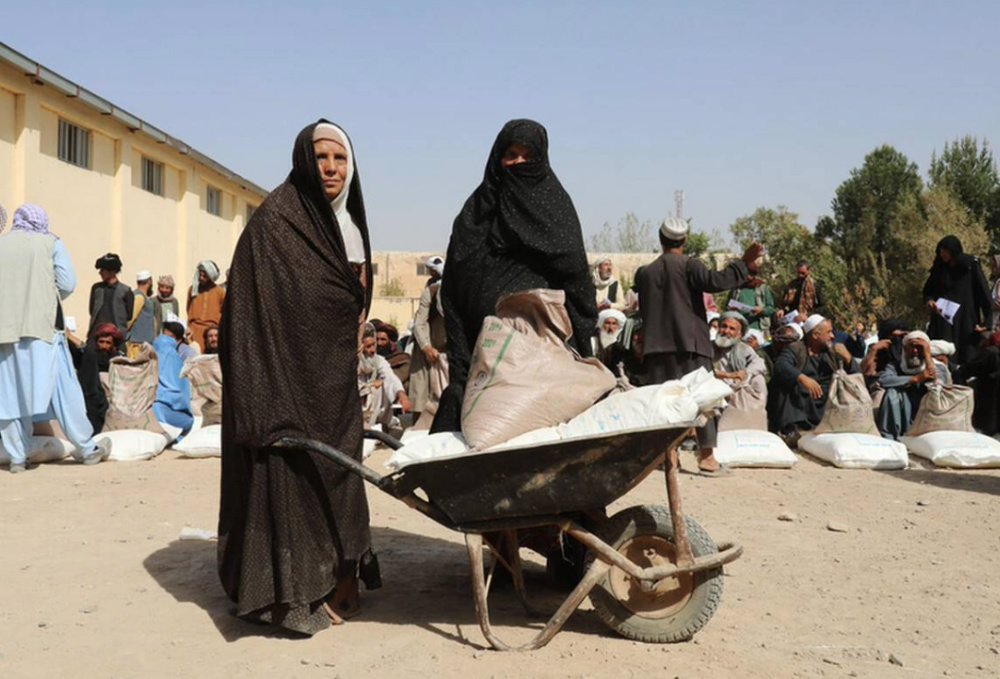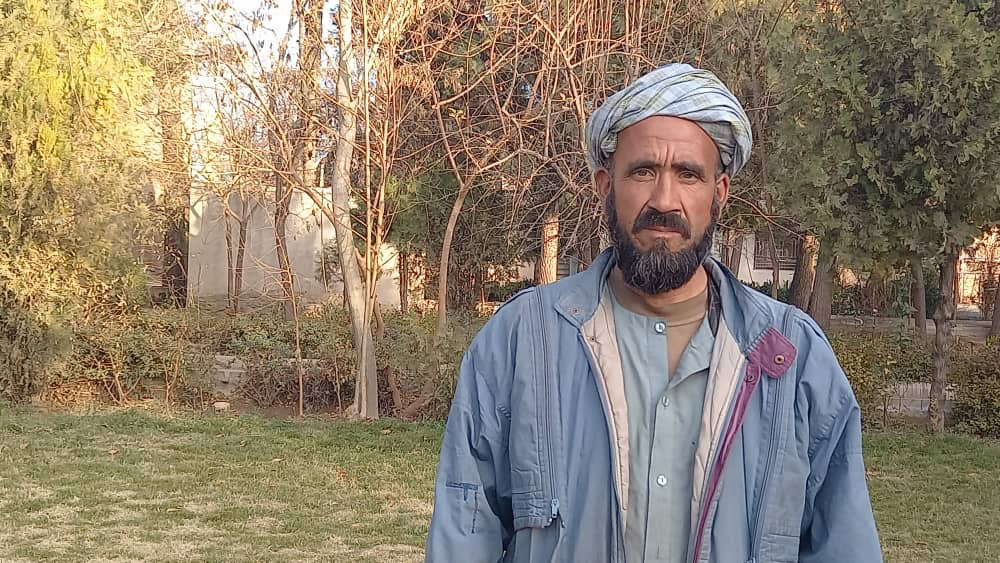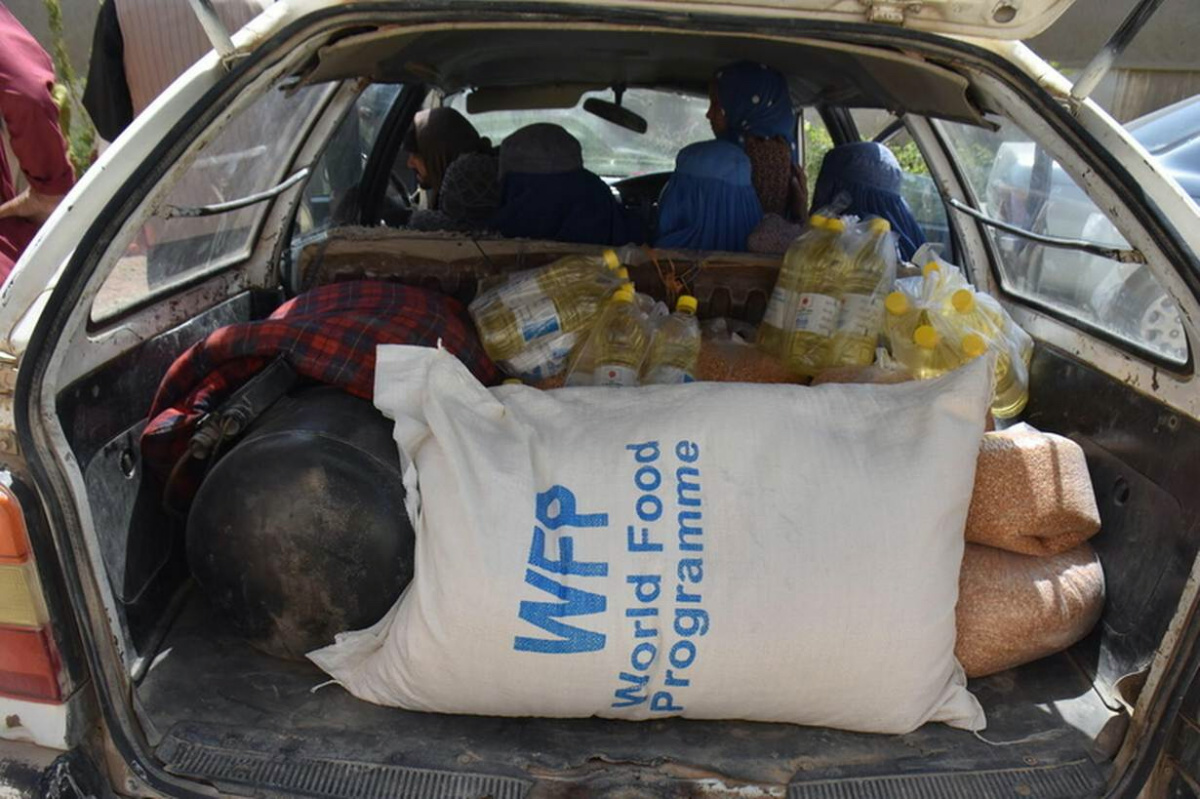
EMMA BATHA, of Reuters, reports on the growing hunger crisis in Afghanistan…
Afghan farmer Abdul Qaher cannot remember a worse drought. Unable to feed his four children after losing his harvest, he took the drastic decision to sell his possessions and move to the western city of Herat to look for work.
Days later, on 15th August, the Taliban seized power, triggering an economic meltdown that has tipped millions into poverty and made Afghanistan one of the world’s worst humanitarian crises.
As the harsh winter sets in, Qaher’s family are among nearly nine million Afghans perilously close to famine.
“The children don’t have warm clothes and it’s becoming very cold. We’re afraid they’ll get sick,” he said.

Afghan farmer Abdul Qaher is seen outside the office of the UN’s Food and Agriculture Organization in the western city of Herat where he is living in a camp for displaced people, on 9th December, 2021. PICTURE: Thomson Reuters Foundation/Handout photo by FAO/Jawid Sultany.
The Taliban’s lightning takeover saw billions of dollars in Afghan assets frozen overseas. International funding, which had supported 75 per cent of government spending, also dried up overnight.
Banks ran short of cash, millions lost work or went unpaid, the local currency nosedived, while prices rocketed.
AFGHANISTAN’S HUNGER AND POVERTY CRISIS IN NUMBERS
With Afghanistan fast becoming the world’s worst humanitarian crisis, UN agencies asked donors on Tuesday for $US4.4 billion in humanitarian aid for 2022, the largest appeal ever sought for a single country. Millions of Afghans are at risk of famine as one of the country’s worst droughts in decades is compounded by an economic meltdown following the Taliban’s sudden return to power last year. Governments responded to the Islamist militant group’s takeover in mid-August by freezing billions of dollars of Afghan assets overseas and halting most international funding to the aid-reliant nation of about 40 million people. Here are some facts about the crisis:
• A record 23 million Afghans – more than half the population – face acute hunger, with nearly nine million one step from famine, according to the World Food Programme.
• Up to one million children under five are at risk of dying from malnutrition.
• Four-fifths of the country is experiencing severe or serious drought. About 70 per cent of Afghans live in rural areas, and 85% derive income from agriculture.
• About 3.5 million Afghans have been internally displaced by violence, drought and other disasters, including 700,000 last year.
• The UN Development Programme has warned that 97 per cent could fall below the poverty line by mid-2022. About half of the population lived in poverty before the Taliban takeover.
• Annual per capita income was $508 in 2020, down from $US650 in 2012. It is expected to fall to $US350 this year.
• Economists predict it could take $US2 billion to lift all people in extreme poverty up to the poverty line.
• Before the Taliban takeover, international aid contributed as much as 40 per cent of gross domestic product, and about three-quarters of government spending, paying for everything from electricity imports to teachers’ salaries.
• Following the takeover, the International Monetary Fund predicted Afghanistan’s economy could contract by up to 30 per cent in 2021.
• Restricting female employment – as the Taliban have done – could inflict an immediate economic loss of between $US600 million and $US1 billion (three to five per cent of GDP).
• Annual development assistance, which was suspended after the Taliban’s takeover, was $US4.2 billion in 2019 – down from a high of $US6.7 billion in 2011, according to World Bank data.
• Humanitarian aid, a smaller portion of overall past assistance, has continued since the takeover, amounting to $US1.72 billion in 2021 – up from $US733 million in 2020 and $585 million in 2019.
Sources: UNDP, WFP, UN Food and Agriculture Organization, the United Nations Office for the Coordination of Humanitarian Affairs (OCHA), World Bank, International Crisis Group.
– EMMA BATHER/Reuters
Hunger and destitution seem “poised to kill more Afghans than all the bombs and bullets of the past two decades”, the International Crisis Group thinktank said, calling donors’ suspension of all but emergency aid “the biggest culprit”.
But finding a way to avert catastrophe is complicated by a slew of long-standing UN, US and other sanctions on the Islamist group, which remains a designated terrorist organisation.
In late December, the UN Security Council and the United States gave aid agencies a green light to scale up life-saving assistance without fear of breaking sanctions.
On Tuesday, UN agencies asked donors for $US4.4 billion in humanitarian aid for 2022, the largest appeal ever sought for a single country.
But analysts said humanitarian aid was only a sticking plaster – liquidity must be injected into the economy to revive business, trade and livelihoods, and frozen money released to pay for crucial services.
“This money is Afghans’ money, and these sanctions are hurting vulnerable people,” Qaher told the Thomson Reuters Foundation on a video call from Herat.
Qaher is among 3.5 million Afghans displaced by drought and insecurity.
His family share one room in a camp on the outskirts of Herat. There is no water or electricity and the temperature falls below freezing at night.
The 45-year-old farmer regularly treks into Herat to find rubbish to burn so the family can cook rice and potatoes. He and his wife skip meals so their children can eat.
With a record 23 million people – more than half the population – struggling to eat, the UN World Food Programme country representative Mary-Ellen McGroarty said Afghanistan faced a “tsunami of hunger”.
Farmers often move to look for jobs in lean times, but the economic crisis has scuppered other labour options.
“It’s created a complete catastrophe. It’s taken away Plan B,” McGroarty said from the capital, Kabul.
“I’ve had women drop at my feet screaming for assistance. I’ve met many men who are scavenging in bins for dry bread to feed their kids.”
When she travelled to the northern province of Badakhshan, elderly farmers who had lived through 19 governments told her they had never seen it so bad.
“They told me they nearly preferred the war to the torture and torment of the hunger they were facing,” she said.

Food distribution on a site on the outskirts of Herat, Afghanistan on 2nd October, 2021. PICTURE: Handout via World Food Programme.
Malek, a 25-year-old farmer from western Afghanistan, used to supplement his income from growing chickpeas, wheat and cumin with casual labour – but nobody is hiring.
He has started selling the few sheep he bought for breeding. Other Afghans are selling everything from motorbikes to jewelry and land. Some are marrying off young daughters for income.
“Winter will be very, very difficult,” said Malek, who only uses one name. “Many people will have to sell assets to buy food.”
Many men in his region have gone to Iran. Malek was considering joining them, but recently received wheat seeds from the Food and Agriculture Organization FAO which he hopes will help him stay put.
FAO country representative Richard Trenchard said he had never seen a crisis worsen so quickly and dramatically, adding that keeping farmers on their land was critical to stave off famine.
“To put it bluntly, farmers don’t die in their fields, they don’t die with their herds. People die on the roads and in camps when they’ve been forced to leave.”
Ironically, aid workers’ access to vulnerable communities has rarely been better. With the end of fighting, the FAO can reach all 34 provinces, up from 25 in mid-2021.
But aid agencies need money and resources. The WFP alone requires $US2.6 billion for the coming year.
The FAO and WFP said the Taliban understood the massive need for aid and were allowing female staff to work, despite imposing restrictions on other women.
The Taliban’s victory marks the first time a sanctioned group has taken over a country, presenting the international community with a dilemma.
The United Nations, World Bank and donors are looking for ways to inject money into the economy without going through Taliban authorities.

Beneficiaries receive their food rations from the World Food Programme in Afghamnistan on 21st August, 2021. PICTURE: Handout via World Food Programme.
In December, the World Bank released some of the $US1.5 billion sitting in the frozen Afghanistan Reconstruction Trust Fund – the previous government’s largest source of funding – to the WFP and UN children’s agency UNICEF.
The United Nations has also paid thousands of health worker salaries, bypassing the health ministry, and set up a trust fund to provide grants to small businesses and work for the unemployed on infrastructure projects.
But analysts say piecemeal fixes will not be enough to avert the country’s collapse.
The ICG thinktank urged the international community to unfreeze assets, ease sanctions and engage with the Taliban to restore basic services including central banking.
“We’re preparing for the world’s biggest aid operation, but maintaining economic restrictions that are increasing the need for aid by the day. It’s self-defeating,” said ICG consultant Graeme Smith.





